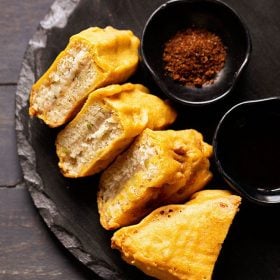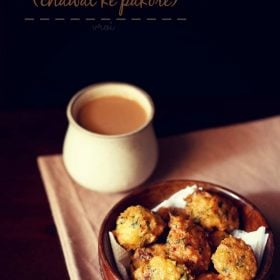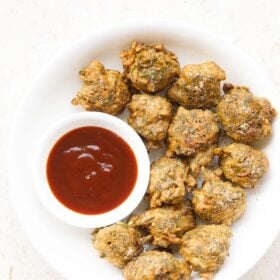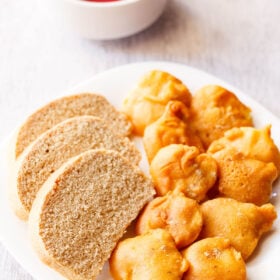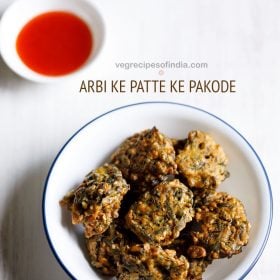Arbi patta pakoda recipe with step by step pics. Crisp and tasty pakoras made with colocasia leaves, gram flour and spices. Colocasia leaves also known as arbi ke patte in Hindi are in season now. So thought of sharing these delicious pakora variety, that I make at times. I follow the same recipe like that of Palak pakoda – just that I add a souring agent and sugar in these pakoras.
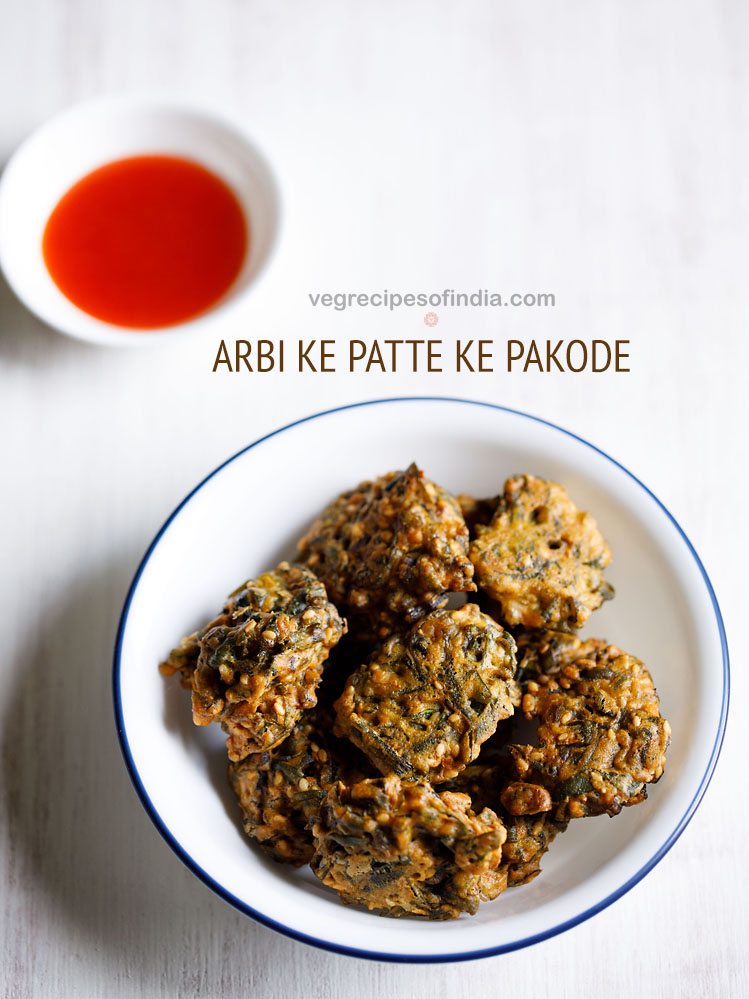
One humble, not so popular plant is the colocasia, which is not just useful for its root vegetable (arbi) but also for its leaves. The leaves are used to make many unique recipes in the regional cuisines of India.
A few recipes that I make with colocasia leaves are – Alu vadi, Alu chi patal bhaji (colocasia leaves gravy) and this Arbi Ke Patte Ke Pakode. This is an easy recipe for crisp and scrumptious pakoras made with colocasia or arbi leaves, gram flour and basic Indian spices.
Since colocasia leaves can be very itchy to the palate, tongue and throat, I recommend to use the small variety of leaves. The larger leaves can be very itchy and even after adding any souring ingredient, the itchiness will be felt. So better not to use them. Also the leaves have to be fresh.
To get rid of the itchiness, you can use any souring agent like curd, buttermilk, lemon juice or tamarind pulp. I have used fresh curd. If using tamarind pulp or lemon, then do not add too much as it will make the pakoras sour. Sugar is added to balance the slight sourness in the pakoras which comes from the curd.
In the recipe I have used both the leaves and stems. Stems also give a good texture and taste. But you can skip them if you want.
Serve arbi ke patte ke pakode hot or warm with any chutney like mint chutney or green chutney or mint coriander chutney or with tomato sauce.
Note: the sensitivity to the calcium oxalate crystals which is present in colocasia leaves differs from individual to individual. The itching sensation is due to the presence of these crystals present in colocasia. So if you know anyone having a strong sensitivity, then avoid making this recipe. The itchiness can be too much and can result in a swelling of the mouth and throat which may require a medical treatment.
How to make arbi ke patte ke pakode
Prep colocasia leaves
1. Firstly rinse 65 grams colocasia leaves or 14 small colocasia leaves very well in running water. Drain all the water.
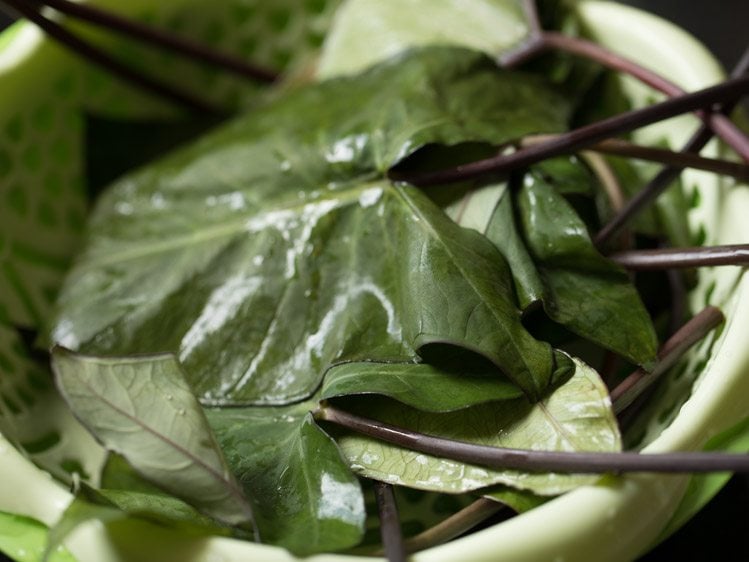
2. Then finely chop the leaves and stems. You will need 1 cup tightly packed finely chopped colocasia leaves along with the stems.
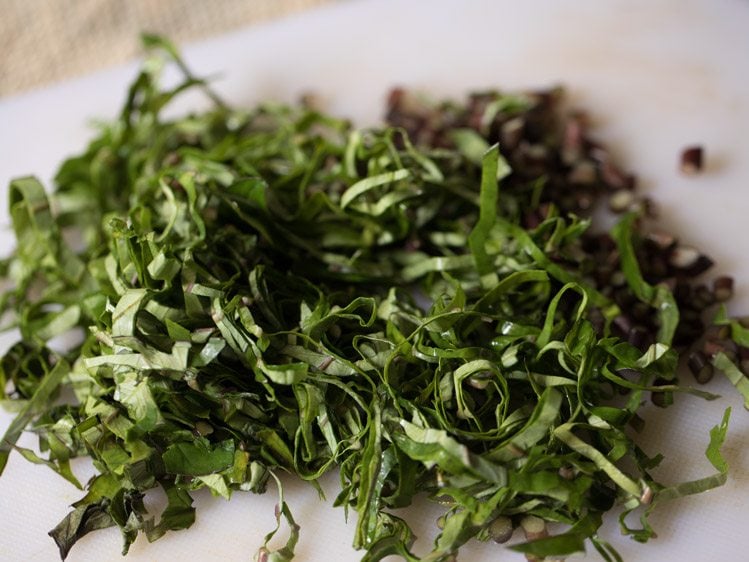
3. Take the chopped leaves in a mixing bowl.
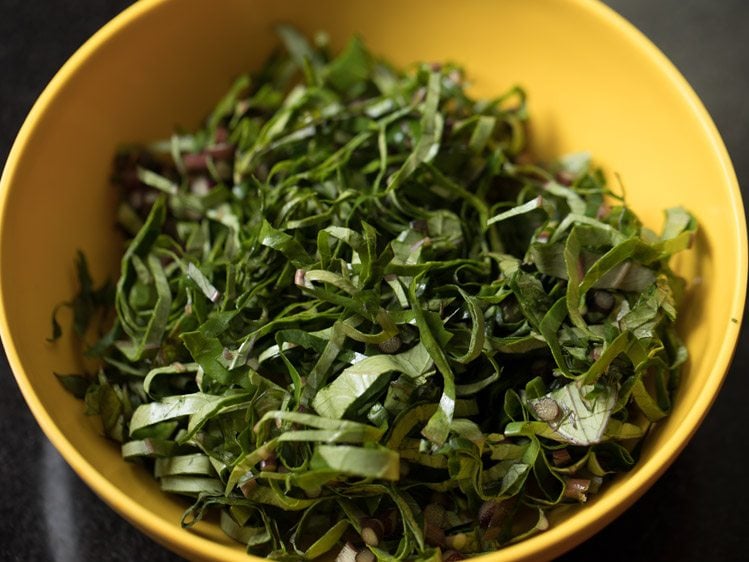
Make batter
4. Add 2 tablespoons fresh curd (dahi). You can also use 1 teaspoon tamarind pulp or lemon juice instead of curd.
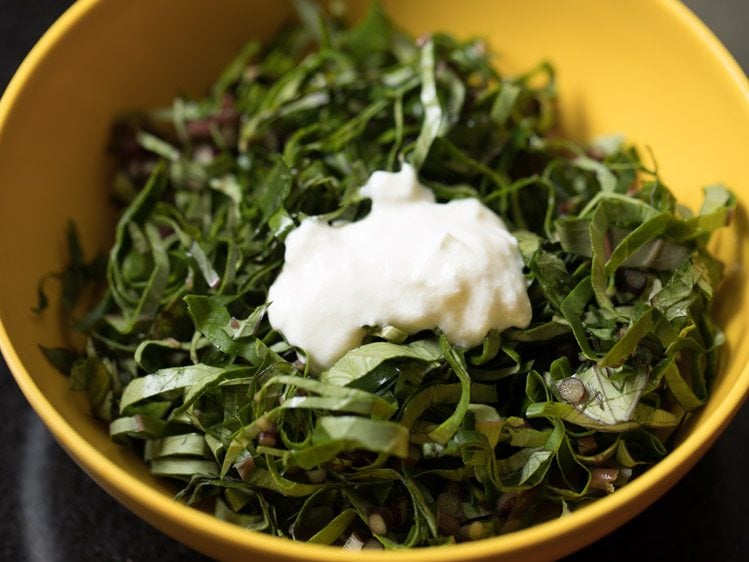
5. Add the following spice powders:
- ⅛ teaspoon or 2 pinches of turmeric powder
- ¼ teaspoon red chilli powder
- ½ teaspoon coriander powder
- ½ teaspoon cumin powder
- 1 generous pinch of asafoetida (hing)
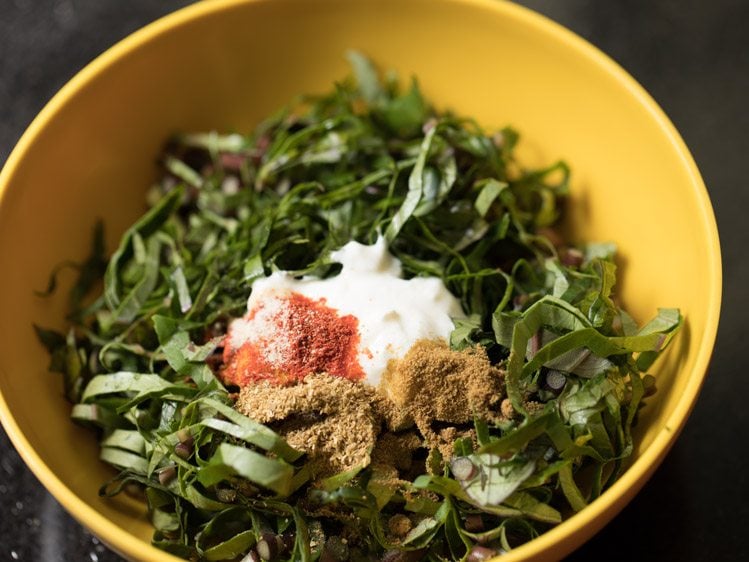
6. Then add ½ teaspoon finely chopped ginger, 1 green chili, (finely chopped) and 5 to 6 curry leaves, finely chopped.
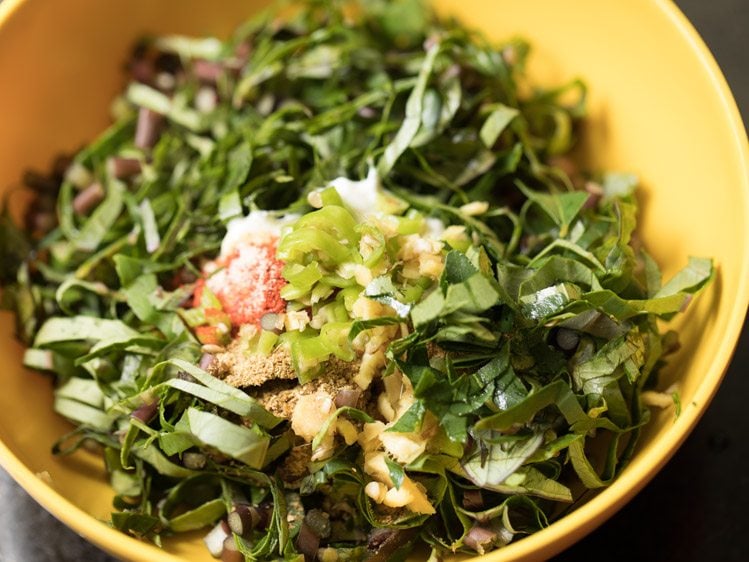
7. Next add 1 tablespoon white sesame seeds.
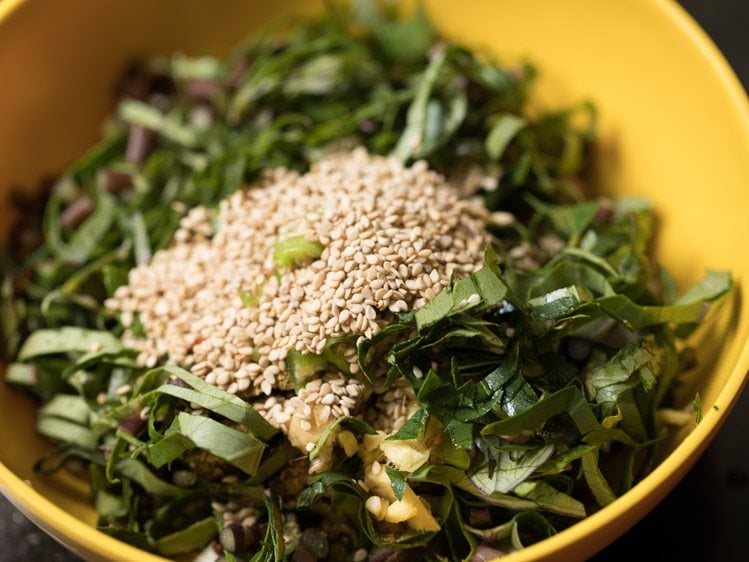
8. Add ½ cup besan (gram flour). Also add 1 pinch baking soda and salt as required.
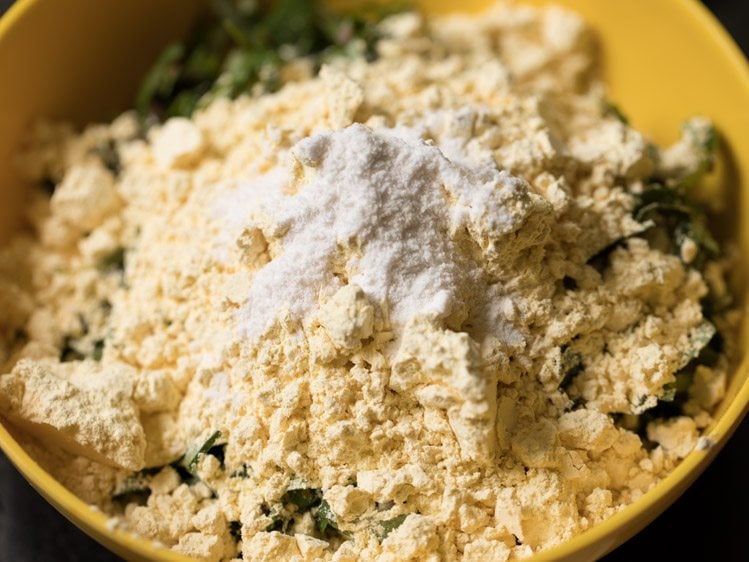
9. Mix everything very roughly. Cover and keep aside for 15 to 20 minutes. Do not add any water.
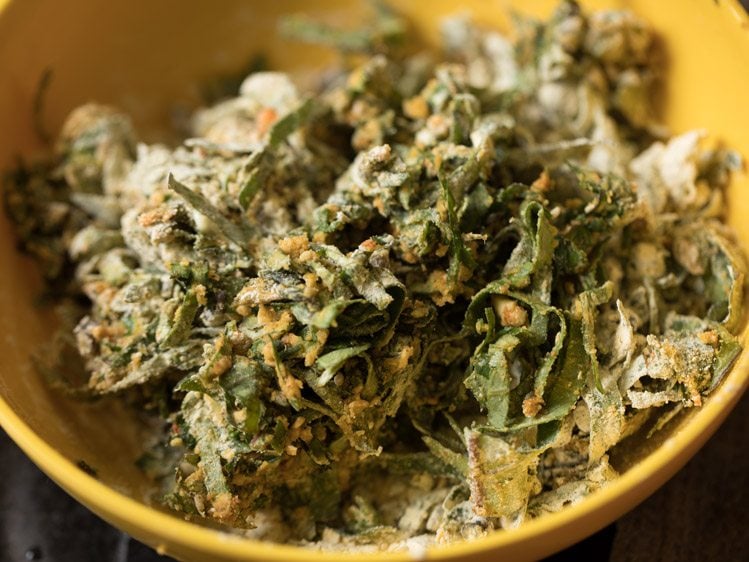
10. After 20 minutes mix again. You will see some moisture in the batter.
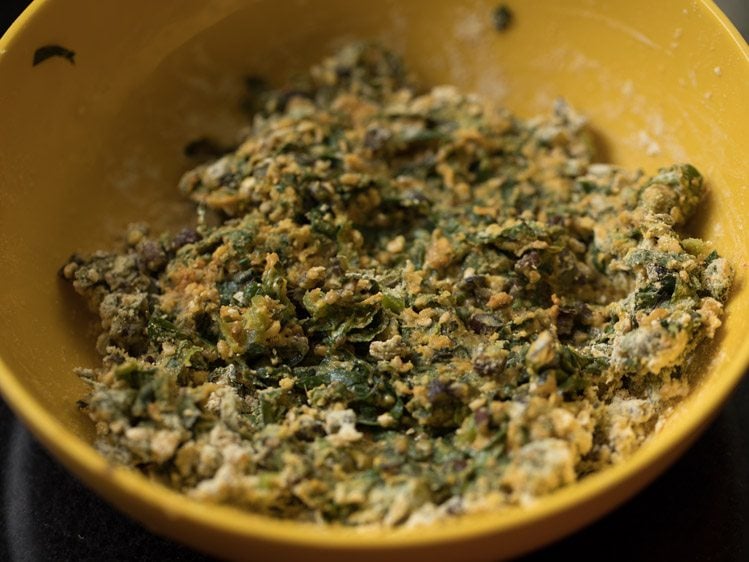
11. Then add water accordingly to make a medium consistency batter. So you can add 2 to 3 tablespoons water in parts or add as required. Do not make a thin batter.
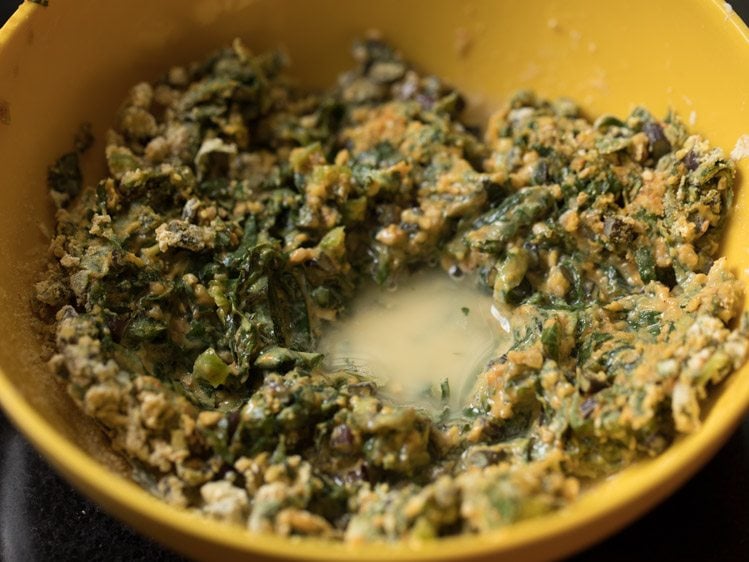
12. Stir and mix well.
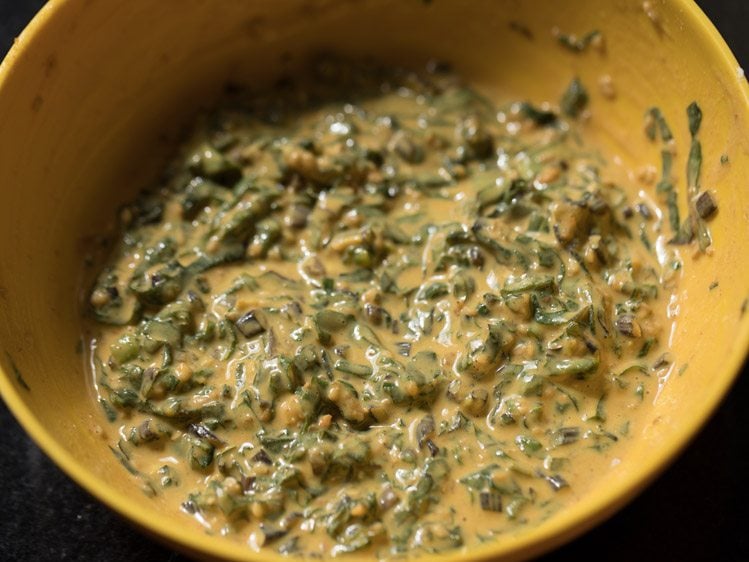
13. Add ½ teaspoon sugar and mix again.
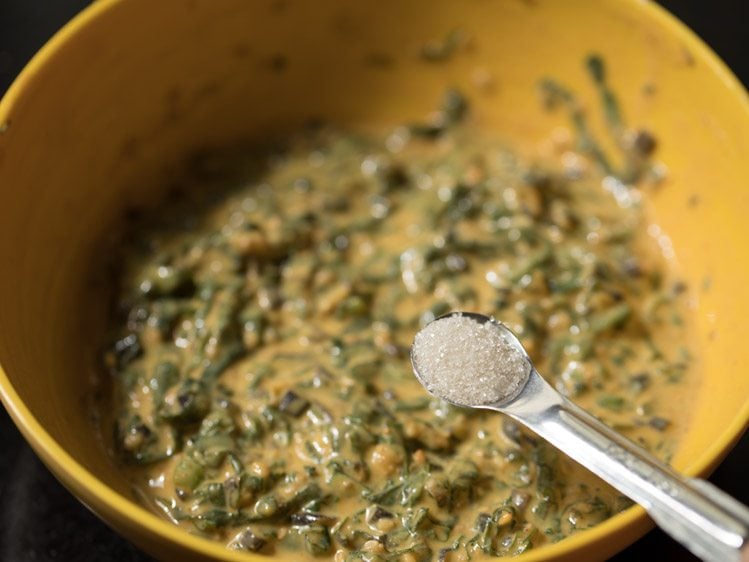
Frying arbi ke patte ke pakode
14. Heat oil for deep frying in a pan or kadai.
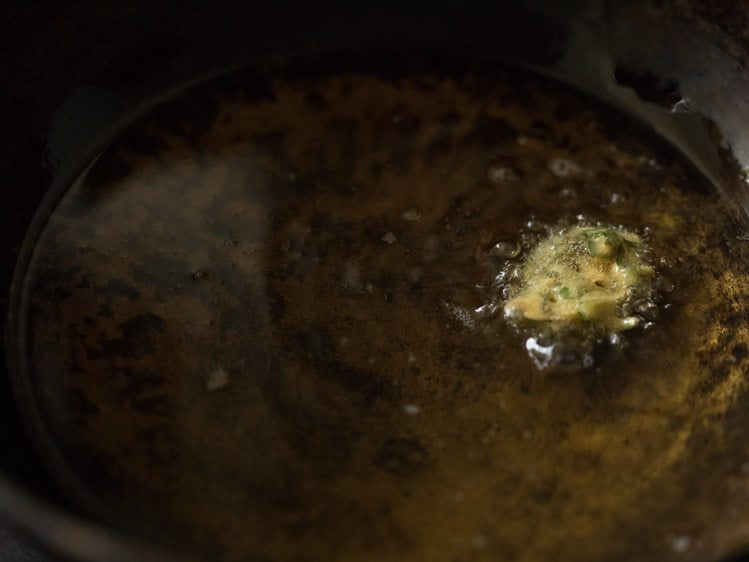
15. Check a small portion of the batter in the hot oil. If it comes up gradually and steadily on the surface of the oil, the pakoras can be fried. Fry pakodas on a medium heat.
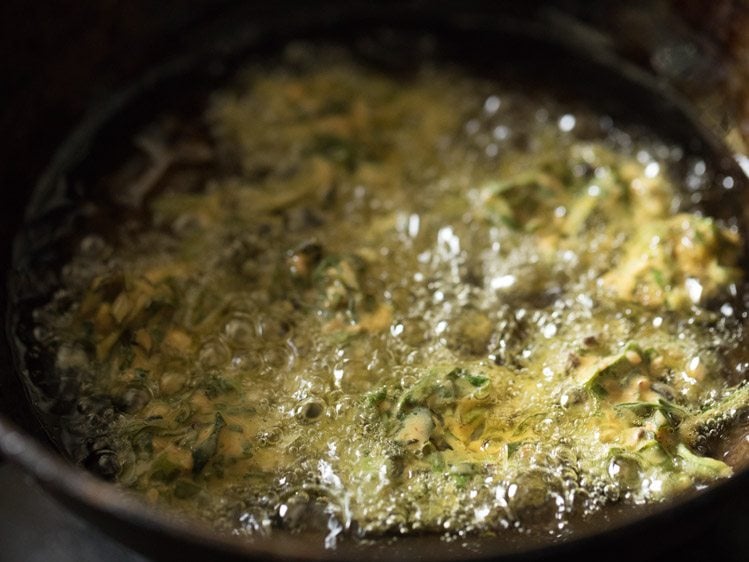
16. Carefully drop spoonfuls of the batter in medium hot oil and begin to fry pakodas.
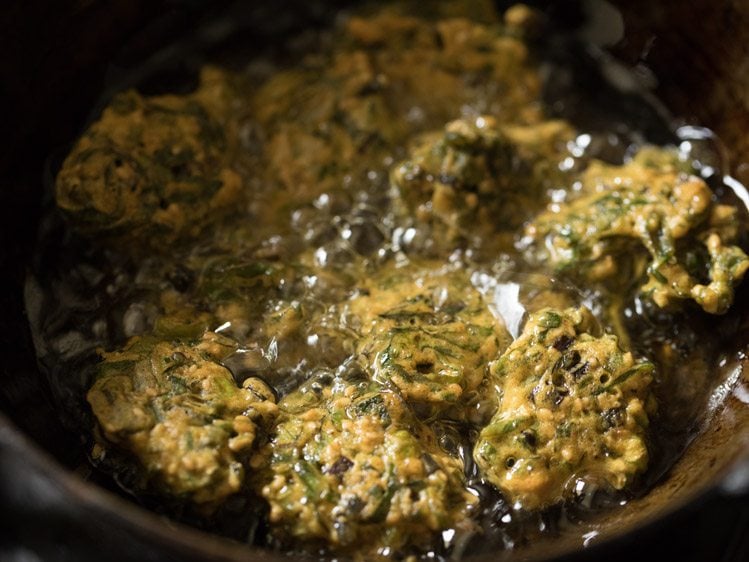
17. When one side is light golden and crisp, then carefully turn over and fry the other side. You can turn over a couple of times more and fry the pakodas till they are crisp and golden.
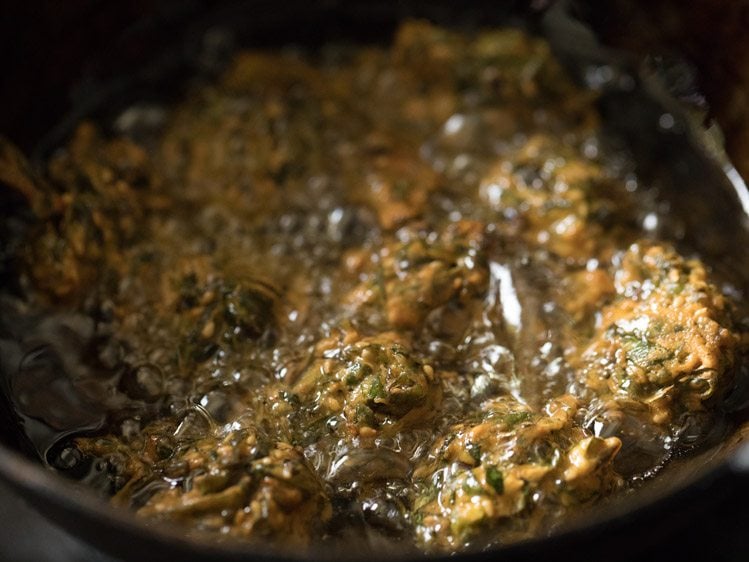
18. Remove with a slotted spoon draining the excess oil in the kadai itself.
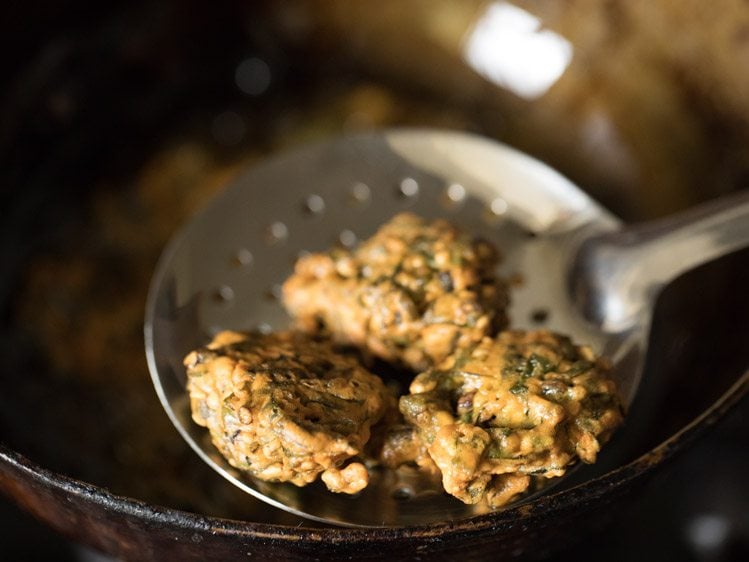
19. Place the fried arbi patta pakodas on kitchen paper towels to absorb extra oil. Fry the rest of the pakodas in the same way.
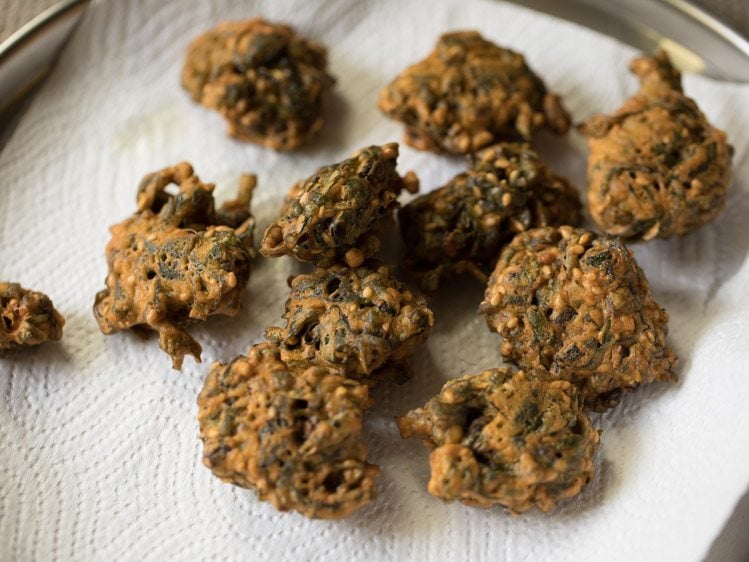
20. Serve arbi ke patte ke pakode hot or warm with any chutney like Mint Chutney or Coriander Chutney or dip of your choice. You could also serve as a tea time snack with Masala Chai or Ginger Chai.
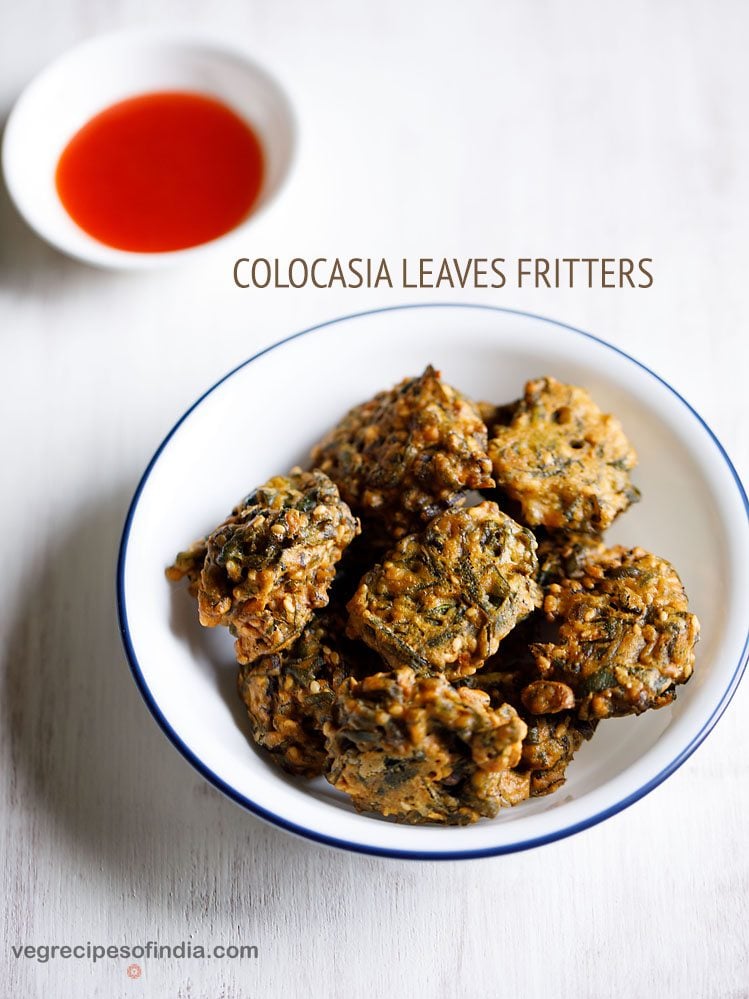
If you are looking for more Pakora recipes then do check:
If you’ve tried this recipe, please rate it in the recipe card or leave a comment below – I’d love to hear your feedback. For more vegetarian inspiration, sign up for my email updates or follow me on Instagram, Youtube, Facebook, Pinterest or X.
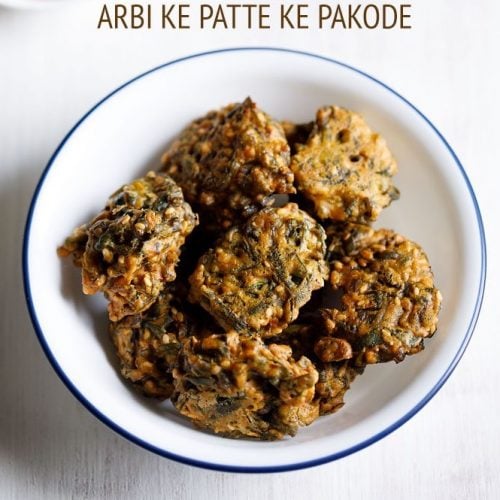
Arbi ke patte ke pakode
Ingredients
- 65 grams small colocasia leaves or 14 small colocasia leaves or 1 cup tightly packed colocasia leaves (arbi ke patte)
- 2 tablespoons Curd (dahi or yogurt) or 1 teaspoon tamarind pulp or lemon juice
- ⅛ teaspoon turmeric powder or 2 pinches turmeric powder (haldi)
- ¼ teaspoon Red Chilli Powder
- ½ teaspoon Coriander Powder
- ½ teaspoon Cumin Powder
- 1 generous pinch of asafoetida (hing)
- ½ inch ginger – finely chopped or ½ teaspoon finely chopped ginger
- 1 green chili – finely chopped
- 5 to 6 curry leaves (kadi patta) – finely chopped
- 1 white sesame seeds
- ½ cup besan (gram flour)
- 1 pinch baking soda
- salt as required
- ½ teaspoon sugar
- oil for deep frying, as required
- 2 to 3 tablespoons water or add as required
Instructions
chopping colocasia leaves
- Firstly rinse 65 grams colocasia leaves or 14 small colocasia leaves very well in running water. Drain all the water.
- Then finely chop the leaves and the stems. You will need 1 cup tightly packed colocasia leaves along with the stems.
preparing batter for arbi ke patte ke pakode
- Take the chopped leaves in a mixing bowl.
- Add 2 tablespoons fresh curd. You can also use 1 teaspoon tamarind pulp or lemon juice instead of curd.
- Add the following spice powders – ⅛ teaspoon or 2 pinches turmeric powder, ¼ teaspoon red chilli powder, ½ teaspoon coriander powder, ½ teaspoon cumin powder and 1 generous pinch of asafoetida (hing).
- Then add ½ teaspoon finely chopped ginger, 1 green chili, (finely chopped) and 5 to 6 curry leaves, finely chopped.
- Next add 1 tablespoons white sesame seeds.
- Add ½ cup besan. Also add 1 pinch baking soda and salt as required.
- Mix everything very roughly. Cover and keep aside for 15 to 20 minutes. Do not add any water.
- After 20 minutes mix again. You will see some moisture in the batter.
- Then add water accordingly to make a medium consistency batter. So you can add 2 to 3 tablespoons water in parts or add as required. Do not make a thin batter.
- Mix well.
- Add ½ teaspoon sugar and mix again.
frying arbi ke patte ke pakode
- Heat oil for deep frying in a pan or kadai.
- Check a small portion of the batter in the hot oil. If it comes up gradually and steadily on the surface of the oil, the pakoras can be fried. Fry pakodas on a medium flame.
- Drop spoonfuls of the batter in medium hot oil and begin to fry pakodas.
- When one side is light golden and crisp, then turn over and fry the other side.
- Turn over a couple of times more and fry the pakodas till they are crisp and golden.
- Remove with a slotted spoon draining the excess oil.
- Place the fried arbi patta pakodas on kitchen paper towels. Fry the rest of the pakodas in the same way.
- Serve arbi ke patte ke pakode hot or warm with any chutney or dip of your choice.
Notes
- You can increase the quantity of green chilies and red chili powder to make spicier pakodas.
- It is best to use smaller and fresh colocasia leaves for this recipe. This is to avoid the itchiness that can be caused by the mature, larger leaves.
Nutrition Info (Approximate Values)
This Arbi ke patte ke pakode post from the archives first published in August 2017 has been updated and republished on December 2022.
